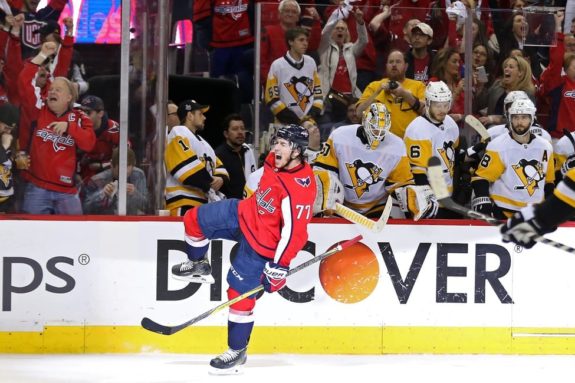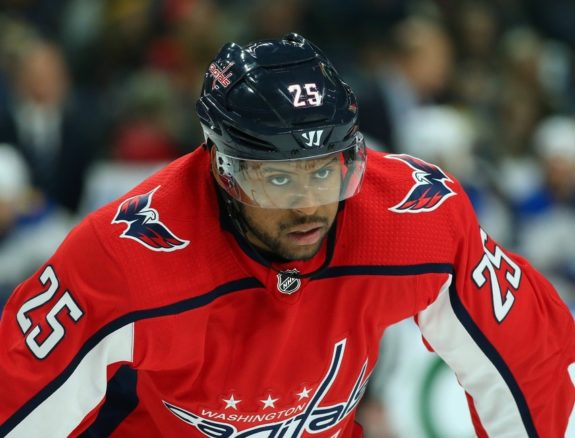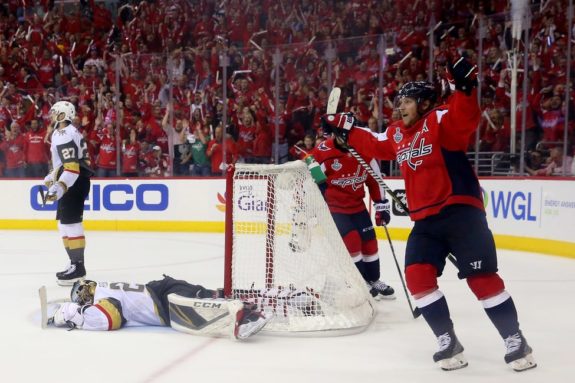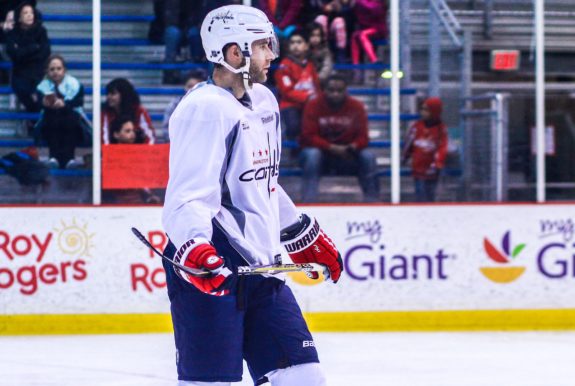The Washington Capitals defeated the Vegas Golden Knights in Game 4 of the 2018 Stanley Cup Final in dominant fashion. The team in red took the contest by a score of 6-2.
Credit is due to the Capitals for pouring on the pressure, but a huge part of the reason for their dominance was a lapse in defense on Vegas’s part. They often gravitated towards the puck carrier, leaving a dangerous weapon open in a prime scoring location. Other times, they were simply out-skated and outmuscled.
Instead of just summing up their lackluster play in Game 4, it’s time to dive into each and every Capitals goal to see exactly what went wrong for the Golden Knights.
Goal No. 1: Penalty Kill in Shambles
Around the halfway mark of the first period, Vegas took a penalty to give Washington a power play. Just over 30 seconds into that man-advantage, T.J. Oshie scored the game’s first goal.
What caused this goal was an indisputable breakdown in the Golden Knights’ penalty-killing unit. While they were unable to stay in formation and take away the center of the ice, the issue went much deeper than that.

First, Nicklas Backstrom skated the puck to the left corner which led to the first problem for Vegas. Two players—Deryk Engelland and Pierre-Edouard Bellemare—got sucked into Backstrom, leaving Evgeny Kuznetsov wide open in the faceoff circle. Taking a look at the replay, you can see he has at least five feet between him and the three Golden Knights closest to him.
Kuznetsov then let a shot go as the penalty killers closed in on him, but the rebound bounced to Oshie, who was crashing the crease. Tomas Nosek, who was covering Oshie, gave him too much space. Then when Oshie was streaking towards the net, Nosek took only a couple strides before gliding in a failed attempt to catch up to the winger in red.
Oshie was able to kick the puck to his stick and lift it over the outstretched pad of Marc-Andre Fleury, giving Washington an early 1-0 lead.
Goal No. 2: Miscommunication
While Vegas won the faceoff in its own zone, Deryk Engelland was immediately swarmed by Alexander Ovechkin and Tom Wilson, who were able to force a turnover. Wilson came out with possession and circled from the corner to the outside hash mark of the left faceoff dot. Wilson proceeded to drop the puck for Kuznetsov, which is where miscommunication plagued the Golden Knights.
Tally #2 courtesy of @tom_wilso hanging out in the slot. #StanleyCup pic.twitter.com/GdrGFUYgDT
— NHL (@NHL) June 5, 2018
Shea Theodore was the closest defender to Kuznetsov, but Jonathan Marchessault, who was originally covering the Capitals center, attempted to tell Theodore that he would continue to shadow his man. Theodore, however, seemed surprised by the sudden drop to Kuznetsov and stopped on a dime in order to retreat and block the center’s open path to the net.
Meanwhile, Marchessault was also attempting to get in No. 92’s way, resulting in two Vegas players doing the work of one. Engelland, the lone defenseman in the slot, tied up Ovechkin, which no one can fault him for. The superstar is clearly the biggest threat Washington has, especially in that region of the attacking zone.
As every athlete knows, for every double team there is an open man. Kuznetsov found the open man in Wilson, who received the puck, paused for a split second, and fired a shot past Fleury from the slot. Thus, the Capitals were up 2-0 late in the first frame.
Goal No. 3: The Failed Clear
With under a minute to go in the first period, the Capitals took a commanding 3-0 lead. What led to this opportunity was the goal scorer, Devante Smith-Pelley, keeping the play alive.

Vegas’s Theodore had the puck in the left corner and decided to flip it up high and out of the zone. There was just one problem—it didn’t make it past the defenseman’s blue line. Instead, Smith-Pelley caught the puck in mid-air and dropped it to his stick. Along the boards, No. 25 got the puck to No. 8, who found refuge in Matt Niskanen at the right point.
Niskanen took a shot that Marchessault was able to get in front of. From there, the Golden Knights simply fell victim to bad luck. The puck took a crazy bounce off of Marchessault and went diagonally across the zone to Smith-Pelley, who was barreling down the left wing. He picked the puck up with his skate, kicked it to his stick, and lifted it over a bewildered Fleury (much like Oshie earlier in the period).
While luck was certainly in the Capitals’ favor, the turnover by Theodore was what led to a play that was deserving of a second look.
Goal No. 4: Outmuscled
The only goal during the second period of Game 4, which put the Capitals up 4-0, was scored on the power play by John Carlson. What led to the goal was the Capitals causing a turnover as well as Carlson’s ability to finish the job.
From the left side wall, the defenseman sent the puck to the back of the net where Backstrom was waiting. His stick was lifted by Brayden McNabb, however, and Engelland was able to take possession behind his netminder. Oshie, however, circled around the net and nudged Engelland off the puck, causing him to fall to the ice—a turnover that proved to be costly for the Golden Knights.
https://twitter.com/NBCSCapitals/status/1003815650995900417
The winger then sent the puck to Kuznetsov as Vegas forward Cody Eakin sunk down to take on Oshie. Eakin went for the puck while his opposition was expecting him to take the body. Thus, Oshie braced himself for impact, which sent Eakin tumbling to the playing the surface.
At this point of the play, Eakin was off his feet, Engelland was just getting back into position, and McNabb was only now entering the slot after pinning Backstrom to the boards below the goal line. This left the middle of the zone wide open. Recognizing that, Kuznetsov sent a dart over to Carlson, who didn’t think twice before rifling a one-timer off the iron and into the back of the net.
Goal No. 5: Backchecking Woes
Washington’s fifth goal began with a 50-50 battle in the neutral zone. Colin Miller was unable to keep the puck in the Capitals’ zone and was then unable to win the battle in the neutral zone. William Karlsson pitched in to help his defensemen, but the Capitals were simply able to outplay them for possession.
Then, none other than Oshie found himself in a one-on-one with Theodore but sensed Miller closing in on him. Washington’s winger decided to drop the puck for a trailing Backstrom and threw on the breaks to hit Miller. The Vegas defenseman seemed to get hit up high, possibly by Oshie’s elbow, but no call was made. After this, No. 6 was quite frankly out of the play as he was left doubled over, grasping at his face in anguish.
Backstrom then, as usual, was able to pick out a target for a pass. Karlsson began backchecking to cover for the battered Miller but was unable to keep his eyes on Backstrom’s target—Michal Kempny. Karlsson failed to even take a stride on this backcheck. Recognizing this, Kempny needed only two strong steps before transitioning into a backward glide to put himself in prime position to execute the one-timer.

Between failing to win a 50-50 battle and a lackluster backcheck, Vegas handed the Capitals a golden opportunity that they simply couldn’t miss.
Goal No. 6: A Broken Triangle
The last goal on Washington’s part was once again on the power play—this time a two-man advantage. The Golden Knights were thus forced into a triangular formation that failed to thwart the Capitals in the dying seconds of the penalty.
At the beginning of the highlight, Vegas formed a standard triangle that spanned from the top of the faceoff circles to the bottom, covering the entirety of the slot. Washington was allowed to pass the puck along the outskirts of the zone, but not through the center.
Backstrom eventually worked the puck behind the net, however, and Theodore followed. This left Luca Sbisa and Eakin alone in front of Fleury as the puck made its way to an open Kuznetsov at the right faceoff circle.
Theodore was unable to hold onto his stick, so instead of skating back to cover No. 92 in red, he was forced to skate all the way around the net. Eakin proceded to go down to one knee in an attempt to block a pass to Backstrom, who had found his way to the doorstep. The pass got by the penalty-killing forward but was deflected by Sbisa and on to Brett Connolly, who backed up the pass.

Then Theodore went down to his knees to block a shot that never came to fruition. All three Golden Knights skaters were now below the hash marks. The high slot was open, and Connolly was able to glide into the open ice and take the shot with little resistance.
Golden Knights’ Poor Defense
While the paragraphs above paint a pretty vivid picture, there is one sentence that one could use to sum up the Golden Knights’ loss in just four words: they played poor defense.
Game 4 hosted countless examples of how the Golden Knights ought not to proceed if they plan on taking home the Stanley Cup in their inaugural season. Due to their lackluster play, which included miscommunication, lazy backchecks, and failed penalty kills, they now find themselves in a 3-1 hole.
With two home-ice appearances remaining out of the potential three games remaining in the 2018 Stanley Cup Final, they still stand a chance of crawling their way back. But in order to do so, they will need to find another gear—especially in their own zone.